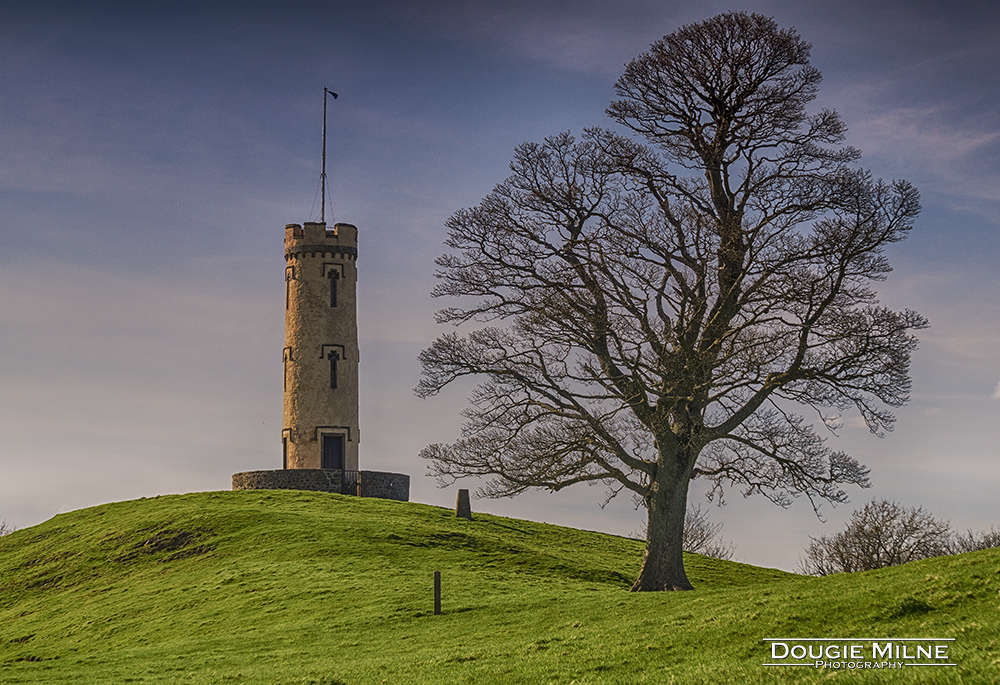
Click on picture for buying options
TweetHigh on the hill behind the House of the Binns sits Binns Tower, also known as Dalyell's Folly and The Wager. It is the highest point for several miles, and shares the location with an official trig point. The hilltop offers superb, 360 degree views. To the north, Blackness Castle, the Firth of Forth and the Forth Bridges are in the immediate foreground, while across the Forth in Fife, the view takes in the naval base at Rosyth, and the Ochil hills beyond. To the south, the view overlooks West Lothian to the distant Pentland Hills.
The tower dominates the landscape and can be seen from almost anywhere between Linlithgow and Hopetoun. It will easily be the dominant feature and focal point of any picture that contains it. Picture it in close up, looking upwards towards the top, or from further away, in profile against the sky. The path up to it from the house may be used as a leading line, drawing the eye towards the tower.
Alternatively, it may be photographed from further down the hill itself, perhaps using the line of the hill itself. Further back, there isn’t a great deal to use as foreground interest, but closer in, the trig point might suit this purpose. The marker post for the Parkland Walk might also be used.
The tower was built as the result of a bet. Sir James Dalyell, the fifth Baronet, and his friends, including Gabriel Dundas, the Laird of Duddingston, gathered for dinner one evening in 1825. Following the meal, the conversation turned to how best to spend £100 - around £9000 today. A wager was suggested, the winner being the guest who could find the most pointless and witty way to spend the money. The Dalyell's had a rivalry with their neighbours the Hopes of the Hopetoun estate, perceiving the latter, with their relatively recently acquired banking wealth, to be less aristocratic. All of the dinner guests were from old, established families, and all agreed that the wager was won by Sir James, who proposed to build a tower on the top of Binns Hill specifically to be seen by, and more importantly, to literally look down upon the Hopes.
The Tower was designed by Alexander Allan in 1826, with architecture matching that of the House of the Binns itself. It was built by Sir James at a cost of only £29 (around £2600 today), keeping the rest of the money for himself. Its foundations are built on to the bedrock of the hill itself. The ground floor was constructed from limestone mortar, surrounded by a gravel enclosure. It stands around 11 metres (36 feet) tall, and had a spiral staircase leading to the viewing platform and faux battlements at the top.
In 1919, the ninth baronet, Sir James Bruce Wilkie-Dalyell, added a windmill to the top of the Tower, in order to generate electricity. This contravened one of the original conditions of the wager: that the tower had to be 'useless'. The sails of the windmill were said to symbolise the Laird of Duddingston chasing Sir James around Hell in pursuit of his money. The windmill was removed in 1935.
The tower fell into disrepair over the years. The internal structure, including the spiral staircase, collapsed. It was restored externally in 2002 by The Pollock Hammond Partnership. Although it is now hollow and not open to the public, the tower is included on the nature trail that has been laid out by the National Trust for Scotland around the grounds of the Binns.
Archaeological studies suggest that Binns Hill was once a Pictish hill fort. According to local legend, it held the last tribe of Picts to be defeated by the Romans. One of these Picts is said to still frequent the site today, in spectral form. He appears as a small, wizened figure dressed in brown, gathering wood on the hillside near Binns Tower, which he then stacks into pyres.
This picture was taken on 2 April 2017.